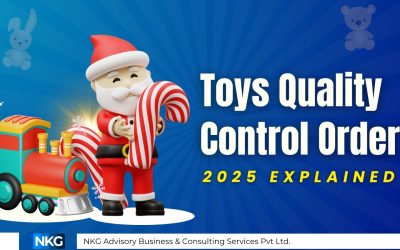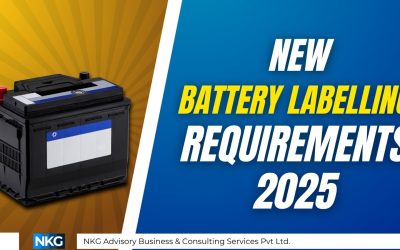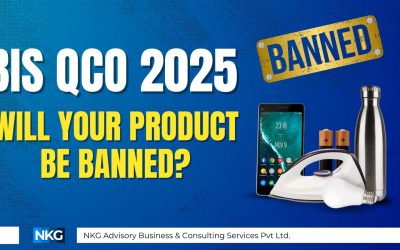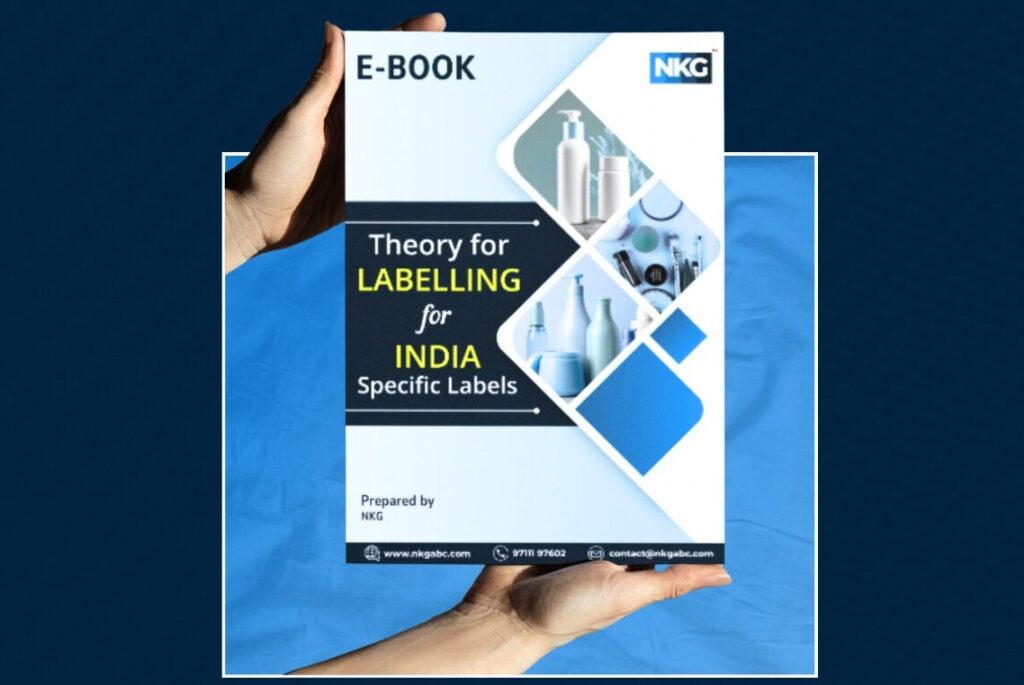Overview of battery waste
A battery is a device that consists of one or more electrically connected electrochemical cells that are designed to receive, store, and deliver electric energy. An electrochemical cell is made by combining an anode, cathode, and electrolyte along with connections (electrical and mechanical) when needed to allow the cell to either deliver or receive electrical energy. The term “battery” also refers to a battery with its electrolyte removed but still whole and undamaged.
When batteries are disposed of it creates large waste in the environment. As batteries are used in various gadgets and have lots of harmful materials, they can get accumulate in one place when disposed of and can cause harm. That’s why recycling batteries is the best substitute to reduce waste. On August 24, 2022, the Ministry of Environment, Forestry, and Climate Change (MOEFCC) released The Battery Waste Management Rules, 2022, to ensure proper management of used batteries.
What is the battery waste management rule?
The Battery Waste Management Rules, 2022, replaced The Batteries (Management and Handling) Rules from 2001. The 2022 Rules introduced the Extended Producer Responsibility (EPR), which makes it the responsibility of the “Producer” (includes any entity that manufactures, sells, or imports batteries, including equipment that includes such batteries) to ensure “environmentally sound management” of batteries.
Waste battery includes:
- A used or end-of-life battery, as well as any of its parts, accessories, or consumables, whether they pose a risk to health.
- Pre-consumer off-spec battery and its parts, supplies, and consumables.
- Battery whose date of use has expired.
- Battery that the user has discarded.
These rules are applicable to:
- Entities engaged in the production, distribution, consumption, transportation, reconditioning, and recycling of waste batteries.
- Batteries of all shapes, sizes, weights, chemistries, compositions of materials, and uses.
Rules exemption is given to:
- Arms, weapons, war equipment, and items designed specifically for use in the military, as well as other equipment related to the protection of crucial security interests.
- Equipment made to be launched into space.
Responsibility of the producer:
- Comply with Schedule I’s prohibitions and labelling requirements.
- Ensure proper handling of batteries and waste batteries to prevent harm to the environment and human health.
Overview of the battery waste management rules
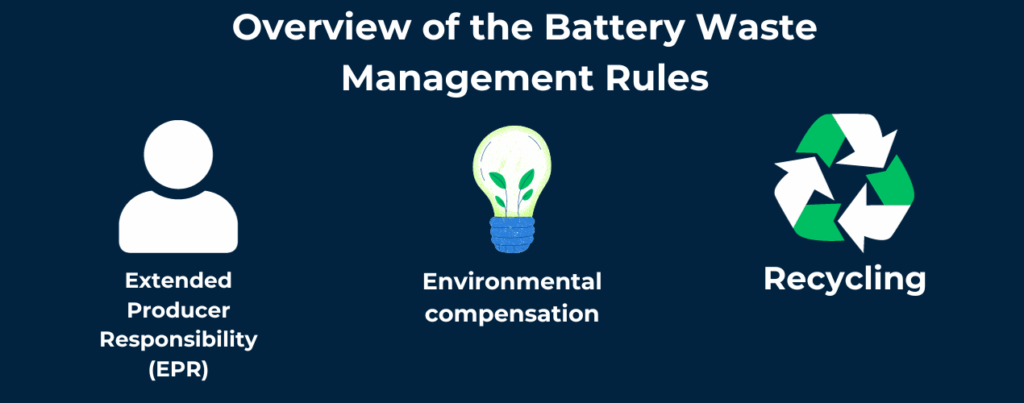
- Extended Producer Responsibility (EPR): The concepts are built on the idea of extended producer responsibility (EPR). Battery makers, including importers, oversee collecting, recycling, and refurbishing used batteries. Additionally, they are in charge of recycling waste products to create fresh batteries. EPR requires that all used batteries be collected and sent for recycling or refurbishment, and it forbids their incineration and disposal in landfills. Producers can arrange for their own collection, recycling, or refurbishment of used batteries to fulfill their EPR obligations, or they can give permission to any other organization.
- Environmental compensation: When Extended Producer Responsibility objectives, commitments, and responsibilities are not met, environmental compensation will be assessed in accordance with the Polluter Pays Principle. Waste batteries that haven’t already been collected and recycled must be done so with the money raised through the environmental compensation program.
- Recycling: According to EPR, all used batteries must be collected and delivered for recycling or refurbishment, and landfill and incinerator disposal are strictly prohibited. Producers are free to work for themselves or to give permission for the use of any other company. The rules promote entrepreneurship and the establishment of new businesses in the collection, recycling, and battery repair industries.
Online portal
The regulations will permit the development of a mechanism and centralised web platform for the exchange of EPR certificates between producers and recyclers/refurbishers in order to fulfil the obligations of producers. Online registration and reporting, audits, and committees for overseeing rule implementation and removing barriers to compliance are the most crucial aspects of regulations for efficient implementation and compliance.
EPR Compliances for Waste Battery
The producers, manufacturers, importers, and refurbishers are each charged with a number of important duties, some of which are listed below:
- The producer who provides the batteries to the market bears the primary responsibility for ensuring that the refurbishing and recycling of the batteries is carried out in accordance with EPR obligations. He must adhere to the collection, recycling, and refurbishing goals in Schedule II of this Act.
- Instead of being burned, used batteries should be sent for refurbishment or recycling. The producers must register themselves with the CPCB by submitting Form 1(A). The EPR registration certificate will be provided to them in Form 1(B).
- Producers must notify the appropriate parties of any changes to the EPR registration details.
- For batteries manufactured the previous year, an EPR plan in Form 1(C) must be submitted to the CPCB by June 30th of each year.
- The producer oversees making sure all labeling and prohibition requirements are followed.
- Manufacturers should also make sure that at least a minimum % of the new batteries’ components are sourced from domestically recycled sources.
Labelling Requirements
- For all batteries and packs, manufacturers must abide by the Bureau of Indian Standards (BIS) regulations.
- Batteries containing heavy metals like lead (Pb), cadmium (Cd), or mercury (Hg) should be marked with the corresponding symbol.
- All labels and symbols must be printed in a clear, permanent, and readable way.
Documents required for the epr certification of batteries waste include
- GST certificate,
- Importer Exporter Code (IEC),
- Ownership documents for the property (rental or lease proof),
- Memorandum of Association (MoA),
- TIN and CIN number,
- Form 1 for EPR authorization, and
- KYC records of authorised signatories are just a few examples.
Conclusion: The regulations apply to all battery types, including those used in industrial, automotive, portable, and electric vehicle applications. The rules are based on the Extended Producer Responsibility (EPR) principle, which states that battery producers (including importers) are responsible for the collection, recycling, and refurbishment of used batteries as well as the use of recovered materials from wastes in the manufacture of new batteries.
EPR requires that all used batteries be collected and sent for recycling or refurbishment, and it forbids their incineration and disposal in landfills. Producers can arrange for their own collection, recycling, or refurbishment of used batteries in order to fulfil their EPR obligations, or they can give permission to any other organisation. To fulfil the requirements, the rules will allow for the establishment of a mechanism and centralised online portal for the exchange of EPR certificates between producers and recyclers/refurbishers.



